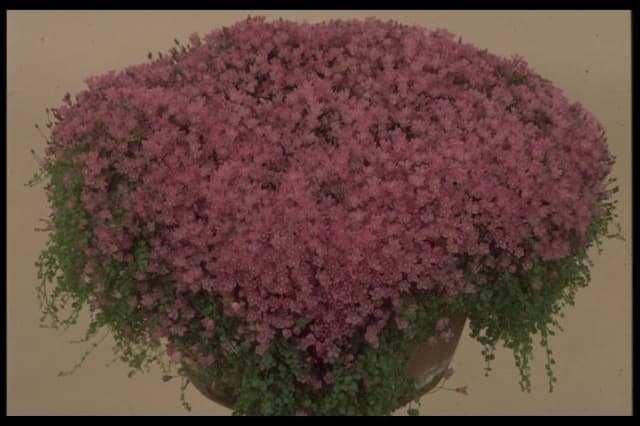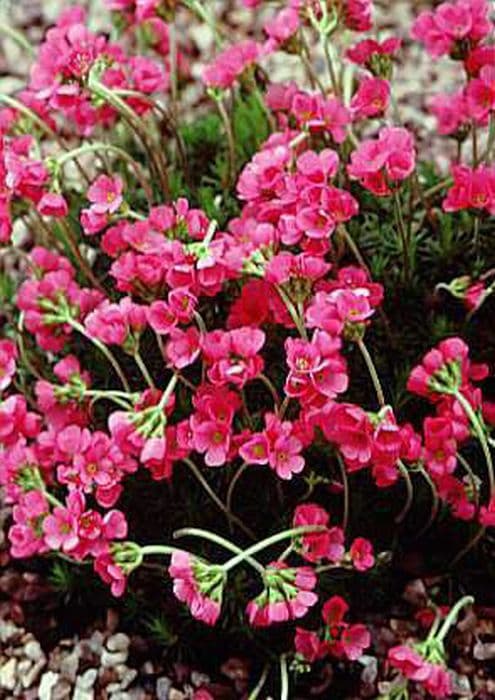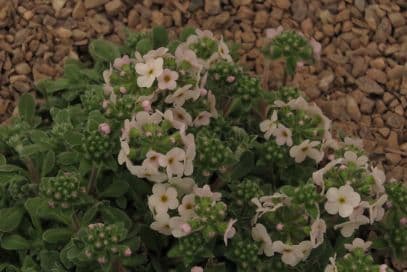Fringed Loosestrife Lysimachia ciliata 'Firecracker'

ABOUT
The Lysimachia ciliata 'Firecracker', commonly known as the Firecracker Loosestrife, is a striking perennial known for its unique and vibrant appearance. The plant is characterized primarily by its foliage and flowers. The leaves are a deep burgundy or chocolate color that make it stand out in the garden against the backdrop of typical green plants. These leaves are lance-shaped, adding a textural aspect with their slightly ruffled edges and a reflective sheen that catches the light. As for the flowers, the Firecracker Loosestrife produces small, cup-shaped blooms that are bright yellow and provide a stark and beautiful contrast against the dark foliage. These blooms are usually arranged in loose, terminal clusters, creating a dappled effect throughout the plant. The stems of the Firecracker Loosestrife are also noteworthy; they match the dark coloration of the leaves and arch gracefully, supporting the weight of the leaves and flowers. This adds to the overall weeping form of the plant, giving it a relaxed yet elegant appearance. It is often the combination of these attributes – the dark foliage, bright flowers, and the arching stems – that make the Firecracker Loosestrife a sought-after plant for gardens aiming for a contrast of colors and a touch of drama.
About this plant
 Names
NamesSynonyms
Firecracker Loosestrife, Fringed Loosestrife, Ciliate Loosestrife.
Common names
Naumburgia ciliata, Naumburgia thyrsiflora, Lysimachia thyrsiflora, Steironema ciliatum.
 Characteristics
CharacteristicsLife cycle
Perennials
Foliage type
Deciduous
Color of leaves
Purple-green
Flower color
Yellow
Height
2-4 feet (60-120 cm)
Spread
1-2 feet (30-60 cm)
Plant type
Herb
Hardiness zones
3
Native area
North America
Benefits
 General Benefits
General Benefits- Attractive Foliage: The 'Firecracker' variety of Loosestrife features deep burgundy to chocolate-colored leaves, adding a unique color contrast to the garden.
- Easy to Grow: This plant is known for being adaptable and easy to care for, thriving in a range of soil types and light conditions.
- Pollinator Friendly: Loosestrife is attractive to butterflies and bees, helping to support local pollinator populations.
- Seasonal Interest: With its colorful foliage and yellow flowers, it provides visual interest from spring through fall.
- Rapid Growth: Lysimachia ciliata 'Firecracker' grows quickly, which can be great for filling in bare spots or creating a sense of fullness in garden beds.
- Soil Erosion Control: The robust root system of Loosestrife can help to stabilize soil and prevent erosion on slopes or in areas with loose dirt.
- Rain Garden Suitable: It is tolerant of wet soil conditions and can be used in rain gardens to manage excess water runoff.
- Naturalizing: The plant spreads readily, which can be ideal for naturalized areas where a wilder look is desired.
- Companion Planting: The rich leaf color can complement other plants in mixed borders, pairing well with greens, blues, and whites.
- Wildlife Habitat: Besides attracting pollinators, it can also serve as a habitat for other beneficial insects.
 Medical Properties
Medical PropertiesThis plant is not used for medical purposes.
 Air-purifying Qualities
Air-purifying QualitiesThis plant is not specifically known for air purifying qualities.
 Other Uses
Other Uses- Lysimachia ciliata 'Firecracker', also known as Fringed Loosestrife, can be used in natural dye production; the plant's parts may yield varying shades of yellow or green, depending on the mordant used.
- Fringed Loosestrife has been utilized in creating ornamental pressed flower art, where its small, star-shaped flowers provide an aesthetic appeal.
- The sturdy stems of Fringed Loosestrife can be incorporated into rustic weaving projects, such as creating wreaths or small baskets for home decoration.
- This plant is occasionally used for educational purposes, to teach students about native plant species and the importance of biodiversity in garden settings.
- In large quantities, it can act as a ground cover to prevent soil erosion on slopes or riverbanks due to its spreading habit and fast growth.
- The tall and striking appearance of Fringed Loosestrife makes it a good candidate for use in floral photography, enhancing naturalistic backdrops.
- Gardeners may use the cuttings of Fringed Loosestrife for propagation, sharing with other enthusiasts interested in cultivating native or ornamental plants.
- The distinctive bronze-hued foliage can provide a contrasting backdrop in terrariums or other glass container gardens, adding depth to the design.
- Fringed Loosestrife can be planted to help define garden paths or edges due to its clumping growth pattern, creating a natural boundary without the need for fencing.
- When planted in close proximity, it can offer a modest level of privacy screening for low-lying areas or foundation plantings around homes.
Interesting Facts
 Feng Shui
Feng ShuiThe Fringed Loosestrife is not used in Feng Shui practice.
 Zodiac Sign Compitability
Zodiac Sign CompitabilityThe Fringed Loosestrife is not used in astrology practice.
 Plant Symbolism
Plant Symbolism- Renewal: The 'Firecracker' plant, commonly known as Fringed Loosestrife, blooms in the summer, symbolizing the idea of growth and rebirth.
- Enthusiasm: With its bright yellow flowers and unique reddish foliage, the 'Firecracker' expresses a sense of excitement and zeal, akin to a firework display in nature.
- Change: The distinct change in leaf color from green to deep burgundy reflects the theme of transformation and the natural cycle of change in life.
- Brightness: The vivid flowers of the Fringed Loosestrife bring a bright and cheerful symbolism, often associated with positivity and joy.
 Water
WaterFringed loosestrife, commonly known as 'Firecracker', requires consistent moisture and should be watered deeply, allowing the soil to be damp but not saturated. Water the plant approximately once a week with about 1 to 1.5 gallons of water, ensuring that the soil is getting moist at a depth of at least a few inches. During hot and dry periods, you may need to water more frequently, possibly every 3 to 4 days. It's important to reduce watering in winter when the plant is dormant or if the plant is subjected to excessive rainfall to avoid waterlogging.
 Light
LightFringed loosestrife thrives best in partial shade to full sun, so it should ideally be planted in a spot where it can receive dappled sunlight throughout the day. Too much direct, intense sun can scorch the leaves, while too little light can hinder its growth and flowering. A location receiving morning sun and afternoon shade, or filtered light akin to the edge of a woodland, is ideal.
 Temperature
TemperatureFor fringed loosestrife, the ideal temperature range is between 50°F and 85°F. It can survive minimum temperatures down to about 10°F to 20°F, but it is not frost-tolerant and may die back in temperatures below this range. During the growing season, keep the plant in the ideal range to encourage robust growth.
 Pruning
PruningPruning fringed loosestrife helps maintain a neat appearance and encourages healthy growth by removing dead or damaged stems. The best time for pruning is in late winter or early spring, just before new growth starts. It is not usually necessary to prune this plant often, as it does not become overly unruly, but it can be cut back as needed to shape the plant or control its spread in the garden.
 Cleaning
CleaningAs needed
 Soil
SoilThe Fringed Loosestrife 'Firecracker' prefers moist, well-draining soil with a good amount of organic matter. The best soil mix for this plant is a combination of garden soil, peat or coconut coir, and perlite or sand to improve drainage. Its preferred soil pH range is slightly acidic to neutral, around 5.5 to 7.0.
 Repotting
RepottingFringed Loosestrife 'Firecracker' generally does not require frequent repotting and can be repotted every 2 to 3 years. Repotting is typically done in the spring when the plant shows signs of being root-bound or when the soil is exhausted.
 Humidity & Misting
Humidity & MistingFringed Loosestrife 'Firecracker' thrives in average room humidity. It can tolerate some variation, but does best when the humidity stays fairly consistent and doesn't get too low. It doesn't need overly high humidity levels.
 Suitable locations
Suitable locationsIndoor
Provide bright indirect light and keep soil consistently moist.
Outdoor
Plant in partial shade to full sun in moist soil.
Hardiness zone
4-8 USDA
 Life cycle
Life cycleLysimachia ciliata 'Firecracker', also known as fringed loosestrife, starts its life cycle when its seeds germinate in the spring after a period of cold stratification, which encourages the seed to sprout. The seedlings grow rapidly in moist soil with partial to full sunlight, developing distinctive burgundy-colored leaves and sturdy stems. During the early to mid-summer, fringed loosestrife enters its flowering stage, producing small, star-shaped, yellow flowers that attract pollinators. After pollination, the flowers develop into seed capsules, which disperse seeds for the next generation once they mature and split open in late summer or early fall. Throughout the growing season, this perennial plant can also spread vegetatively by sending out rooting stolons, creating new clones of itself. As winter approaches, the aerial parts of fringed loosestrife die back to the ground, with the roots surviving the cold to regenerate the plant in the following spring.
 Propogation
PropogationPropogation time
Spring-summer
The Lysimachia ciliata 'Firecracker', commonly known as Fringed Loosestrife, is best propagated in late spring to early summer when the plant's growth is most active. The most popular method for propagating Fringed Loosestrife is by dividing its clumps. This involves carefully digging up an established plant and gently separating the root mass into several smaller sections, each with a portion of the root system and some shoots. These divisions can then be immediately replanted in moist, well-drained soil, spacing them about 10 to 12 inches (approximately 25 to 30 centimeters) apart to give them ample room to grow. Make sure to water the new divisions regularly until they are well-established, which usually takes a few weeks.









